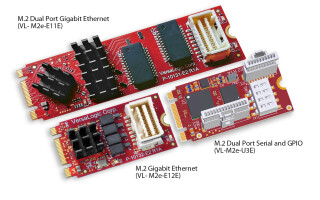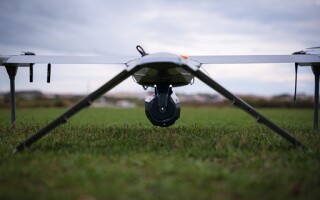ISR sensors, GaN materials, multicore processors dominant tech trends in 2015
StoryDecember 22, 2015

Every month the McHale Report will host an online roundtable with experts from the defense electronics industry ? from major prime contractors to defense component suppliers. Each roundtable will explore topics important to the military embedded electronics market. This month we discuss the technology game changers and market highlights from 2015 in the military electronics market as well as make predictions for 2016.
This month’s panelists are: Rob Smith, Vice President of C4ISR at Lockheed Martin; Gerry Janicki, Senior Director at Meggitt Defense Systems; Doug Patterson, VP Military and Aerospace Business at Aitech Defense Systems; Bryan Goldstein, General Manager of the Aerospace and Defense business unit at Analog Devices.
MCHALE REPORT: What technology was a game changer for military electronics in 2015?
SMITH: In C4ISR [Command, Control, Communications, Computers, Intelligence, Surveillance and Reconnaissance], the advancements that have been made in all source sensor fusion have greatly increased our abilities to deliver intelligence to decision makers. We are operating in a world where the volume of sensor data in the spectrum is astounding – currently in the petabytes and increasing at a staggering rate. The challenge now is to make better information out of this enormous amount of data. Activity-based intelligence and object-based production have helped in that regard. In 2015, our C4ISR team focused on automating the intelligence cycle, implementing predictive intelligence, and improving multi-INT fusion, analysis and correlation, so our customers can access higher quality information faster reducing the data to decision cycle.
JANICKI: The spread and real application of GaN [Gallium Nitride] and SiN [Silicon Nitride] electronic materials technology in higher performance electronics and embedded electronics in additive manufactured components.
PATTERSON: The advent of multicore processors from Intel and Freescale as well as the use of multicore ARM processors in nearly every Smartphone, everywhere. Integrating the memory crossbar switch into the processor silicon took the bane of memory bandwidth limitations out of the “lower performance” and “memory thrashing” equations altogether. Faster and larger memory has fueled more software developer creativity and more functional and capable systems. Software and operating systems, supporting virtual memory, multi-user and multiprocessing parallel executions of applications simultaneously, have advanced to finally start meeting the promises of true portability and application auto-level loading.
Applying this high speed, multi-core technology from the enterprise to the personal computer (PC) has provided a wide and diverse tool chain that enables a more robust application development environment, fueling faster and enhanced parallelism. It’s really all about the tools we develop and use to make better tools… the cycle continues.
GOLDSTEIN: From an ADI perspective the game changer may not have been a technology so much as it was the acquisition of Hittite Microwave which gave us the ability to provide complete system-level solutions from the antenna to bits and back. The ability to optimize complete solutions, particularly with digital signal processing used for calibration and assistance, is a game changer in that we are now able to relieve many of the past analog and RF challenges encountered in overall system designs.
MCHALE REPORT: Did the year fall short, meet, or exceed your expectations from a market performance perspective?
JANICKI: The year was a little short in market performance due to a late developing and approved 2016 defense budget as the fear of sequestration and Continuing Resolution until late fall hurt orders to second and third tier suppliers of military electronics and complex subsystems.
SMITH: The market met my expectations. While the DoD budgets continued a challenging environment for our customers, we have seen selected areas of growth, especially in the area of electromagnetic warfare, and the convergence of electronic warfare/ signals intelligence (SIGINT) and cyber. I continue to expect the domestic market to slowly improve over the next few years. International markets continue to be an opportunity for growth with typically longer acquisition timeframes.
PATTERSON: For all the same reasons as the past seven years, the year again fell short in the defense and aerospace markets. Take lackluster performance in the private and military sectors weighed down by new draconian government health care (ACA) laws and continual policy changes and add increased spending for “feel good” social programs, with no attention paid to controlling the national debt.
Honestly, how could any defense & aerospace CEO convince their boards of directors that technology internal research and development (IR&D) and new hire investments in 2015 were the right thing? The past year showed a continually down-spiraling economy with little to no chance of compromise of nearly any funding bills coming out of the U.S. House or Senate, or if they did, the executive branch held the veto our for ransom.
GOLDSTEIN: Although it was expected that the 2015 market would see some rebound after the recent challenging years of sequestration and troop withdrawal from the Middle East, it is fair to say that the rebound for us was better than expected. The military’s increased spend on electronic upgrades over the last few years has started to really pay dividends.
MCHALE REPORT: How did the DoD budget cuts and sequestration effects of recent times affect 2015 and do you see it continuing/changing in 2016?
PATTERSON: Regarding sequestration’s current effects, by “swinging the big stick”, the House Republican conservatives wound up with the opposite affect they expected, or wanted… to hold the Executive, House, and Senate Democrats at bay with the threat of automatically cutting the nation’s defense budgets. But this is exactly what the Democrats wanted so they could siphon funds to their pet social programs, global warming research (and negative ad campaigns) and alternative “green” energy research. As Speaker of the House, Wisconsin’s Paul Ryan has been able to finally pass a $1.1 trillion budget through Congress that Pres. Obama says he’ll sign and finally put a (albeit horribly unbalanced) budget in place for the next nine months.
Finally, the CEOs of the larger defense primes can start to predict and allocate internal funds against a more stable forecast of known – and funded – aerospace and defense programs. This will start freeing up previously unallocated capital and spur growth in the market. As for continuation into this year, the answer should be no, now that there’s a budget that’s law, eliminating “continuing resolutions to provide temporary supplemental funding” to fund the government. Hopefully the stupidity of sequestration is behind us once and for all, chalked up as the total disaster it was – for every U.S. taxpayer.
GOLDSTEIN: The DoD budget cuts and sequestration caused a lot of uncertainty in the market, with the future of a number of programs undetermined or delayed. Overall, this trend seems to have ended but some challenges still lie ahead. The latest example is the delay of the 2016 DoD budget by Congress with a number of programs outlined recently as needing to be pushed out in time. Having said this though, the longer term trends in AESA radars, advanced communication, and next generation electronic warfare systems are likely to increase the demand for advanced electronics that will drive defense technology investment and business growth.
SMITH: In this austere environment, I think that we’ll continue to see DoD focus on affordability. There seems to be a shift away from “exquisite” capabilities toward “expendable capabilities.” We also see much more incremental capability expansion rather than new systems. Developing systems and capabilities to counter threats and defeat adversaries will be environmentally driven by issues such as existing technology available, the cost to develop new capabilities, budgetary issues, new acquisition models, and the realities of the global security environment.
JANICKI: See my response to the second question. [In addition] I do see an improvement with a real 2016 budget, with again a challenge in 2017 during an election year.
MCHALE REPORT: What will be the disruptive technology or disruptive trend for 2016 in the military electronics industry? Predict the future.
GOLDSTEIN: Although not a new technology, 2016 is likely to see an increase in the use of Silicon Germanium (SiGe) technology for advanced radar and communications systems. SiGe and CMOS technologies are both being widely exploited in next generation mixed signal systems, where digital and analog functionality are combined to provide lower size, weight, and power (SWaP) and potentially lower cost solutions. In 2016, the increase of SiGe designs for phased array radar functions, for example, is expected to be significant. Another recurring theme is the advancement of GaN technology. he increased power density/power handling relative to GaAs [Gallium Arsenide] devices as well as the improved reliability relative to Travelling Wave Tubes is showing tremendous growth opportunities.
SMITH: Technology has the potential to minimize the time lag in providing “actionable” information to the tactical user. Distributed decision making in contested environments will continue to improve. New fifth generation platforms will continue to be disruptive and significantly improve capabilities. EW and Spectral capabilities will continue to draw interest. Every platform is a sensor, and every sensor is a part of the network with the ability to reconfigure and make coordinated decision faster and at the node. Hence the need for system architectures that support tighter integration of all intelligence assets with their command and control systems. That said, while there are many technologies that are evolving quickly, software that improves big data analytics, data fusion, and the ability to probabilistically predict likely events in the future will be THE great enablers. To enable all this, our team will continue to develop technologies that move the right data to the warfighter whether it be precise information to the cockpit or information to flag officers to support their decisions.
JANICKI: Additive Manufacturing continues to evolve at a dizzying pace with several manufactures embedding electronics into high temperature reinforced thermoplastic assemblies. I believe the future of small complex electronic sensors, UAVs [unmanned aerial vehicles] and UGVs [unmanned ground vehicles] will really benefit from this continued breakthrough in affordable development and production using aerospace and defense grade material and electronics.
PATTERSON: Cheaper multicore processors will be the norm for nearly all applications, with operating systems and apps taking advantage of the huge increases in parallelism. Prices of the processors and memory will drop quickly as demand increases almost exponentially across all markets: commercial/consumer, industrial and defense. Inter-processor communications will continue to rise quickly and efficiently, passing multiple gigabytes-per-second of data between local (on-board) nodes as well as nodes across board boundaries via high-speed copper, then optical pathways as the fears of implementing and using optical fiber are swiftly moved to the past.





